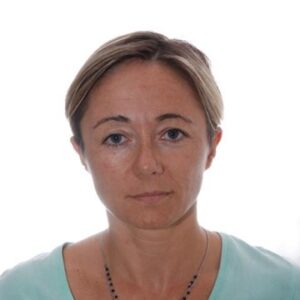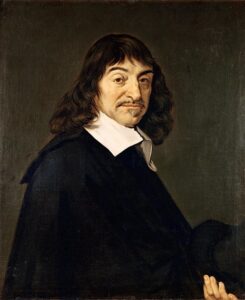
“Realistic image of the brain mathematically computing the position of a quantum in space and time” by ideogram.ai
By James Myers
Scientists are probing the frontiers of consciousness with some intriguing connections to mathematics and quantum mechanics. If science derives a formula for consciousness, what will it say about our individual consciousness of consciousness itself?

Dr. Rosa Rugani. Image: University of Padua
There has long been evidence for an innate mathematical ability in humans, and we’re gaining an appreciation that mathematical understanding is intrinsic to the brains of other conscious animals. Last year, The Quantum Record reported on the work of Dr. Rosa Rugani, from the University of Padua, which demonstrated that newly hatched, untrained chicks could keep track of the number of items behind screens based solely on watching them moving from behind one screen to the other.
The scientific search continues for the basis of consciousness. For instance, since 1994 the University of Arizona has organized a biannual Science of Consciousness conference at different locations attracting international participation. For decades, scientists have been exploring connections to consciousness at the level of the quantum, which is the tiniest bit of energy in the universe that can either cause physical change or be changed physically, and is the basis for quantum computers now under development.
A significant challenge in the quantum computer is “decoherence” of connections (called “entanglements”) between quanta (which is the plural of “quantum”). In the computer, the quantum is extremely susceptible to disruption from heat, electromagnetism, and other “noise” from the external environment that cause quantum circuits to disconnect and fail.

Illustration of quantum decoherence. Image by Gabrielle Meilikhov/Muza Productions, published by Princeton University.

Vlatko Vedral. Image: www.vlatkovedral.com
On the basis of this experience with the emerging technology, it has been argued by some that the brain is too wet and too warm to be capable of quantum computations. Citing the 1988 paper by Matthew Donald entitled “Quantum Theory and the Brain,” University of Oxford physicist Vlatko Vedral writes, “However, this argument is not correct. Quantum processes still take place in the brain (and everywhere else) at timescales that are short enough and scales that are small enough for noise not to be able to affect them much. It is perfectly possible that gazillions of such small quantum processes add up to something that ultimately contributes to the brain’s functionality (and, I emphasize again, completely independently of whether or not we believe it to be conscious).”
Physicist Roger Penrose famously proposed that consciousness operates in an “orchestrated objective reduction” (Orch-OR) of quanta.
Penrose’s assembly of the mathematical tools to describe black holes won him the 2020 Nobel Prize in Physics. In his 1989 book The Emperor’s New Consciousness, which explores the basis for consciousness, he argued that since mathematician Kurt Gödel’s incompleteness theorems prove that a formal system cannot prove its own consistency, human mathematicians are therefore capable of unprovable results. “Penrose took this to mean that human mathematicians are not formal proof systems and not running a computable algorithm.”
Penrose’s proposition was that each conscious entanglement among quanta has a unique position in the curvature of space and time. He wrote that when successive entanglements become separated by more than one Planck length, the result is a collapse of the quantum wavefunction – which oscillates between multiple states in space and time – and therefore fixes an “observation” at one specific point of spacetime.
The Planck length is the universal minimum length of a unit of energy, which The Quantum Record examines in our feature, Evolution of the Universe: Why Measuring Voids of Nothing Tells Us Something.

2020 Nobel Prize in Physics recipient Sir Roger Penrose, who discovered “that black hole formation is a robust prediction of the general theory of relativity.” Image: nobelprize.org.
After observing the neural activity of anaesthetised patients, Penrose and anesthesiologist Stuart Hameroff proposed that the process of conscious observation occurs within tiny tubes in the brain, called “microtubules,” and that the closing of a particular microtubule constitutes a conscious observation. It’s as if the microtubule’s closing shuts off a particular flow of physical information, perhaps redistributing the remaining unobserved probabilities to future potential.
In its January 2024 cover story, New Scientist reported on a 2023 study by physical chemists Aarat Kalra and Gregory Scholes on the propagation of energy through the brain’s microtubules. Using a fluorescent dye for observation, they were surprised that “energy diffused about five times further than expected according to classical calculations, suggesting a quantum phenomenon was at play in the microtubules. ‘It’s likely some kind of quantum resonance,’ says Scholes.”
Some scientists caution, however, that there are so many variables at play in measuring energy diffusion that it is difficult to draw a conclusion from the work of Kalra and Scholes.
Penrose’s view of consciousness is a contrast to the relative computability of the physical universe. Albert Einstein established the computability of physics in the field equations that underlie his famous E=mc2, and in her theorems mathematician Emmy Noether (1882-1935) indicated that for each physical constant there exists a universal symmetry. The computability of outcomes in the physical universe remains, however, subject to physicist Werner Heisenberg’s Uncertainty Principle, which says that the more information we have on a particle’s position in space the less information we have on its momentum in time, and vice versa.
It seems that computability, like the base of the natural logarithm, is a function of limits.
The Mathematics of Consciousness

Lenore Blum, pictured in 1998. Image: Wikipedia.
In 2021, the Association for Mathematical Consciousness Science (AMCS) was founded by Dr. Lenore Blum, a former Vice President of the American Mathematical Society and Professor-in-Residence of Electrical Engineering and Computer Sciences at UC Berkeley. The AMCS consists of over 150 international researchers spearheading mathematical and computational approaches to consciousness.
As its website explains, “The AMCS grew out of an informal community of researchers who have been running conferences, seminars and workshops during the past several years, who view mathematical approaches to the understanding of consciousness as complementary and supportive of the scientific study of consciousness.”
In conjunction with the Oxford Mathematics of Consciousness and Applications Network and the Mediterranean Society for Consciousness Science, the AMCS hosts a seminar series with some of the sessions available on its YouTube channel.

Stephen Wolfram. Image: Wikipedia
Included in the series is a presentation by mathematician, physicist, and computer scientist Stephen Wolfram entitled “What it’s like to be a computer,” in which he speaks of the “ruliad.” Wolfram explains, “The ruliad is this entangled limit of all possible computations. It’s a unique, necessary object that, once you have the defining idea of computation, it has to be constructed in the way that it’s constructed. The realization that our experience of the world is a consequence of us sampling the ruliad from within the ruliad: we are part of the ruliad, but we are sampling the ruliad and in that sampling we are getting the experience we get of the world.”
The AMCS issued an April, 2023 open letter in response to the Future of Life Institute’s open letter “Pause Giant AI Experiments,” which was triggered by concerns over OpenAI’s ChatGPT technology.
In its letter, the AMCS noted that “There are over 30 models and theories of consciousness (MoCs and ToCs) in the peer-reviewed scientific literature, which already include some important pieces of the solution to the challenge of consciousness.” The letter concludes, “Research in consciousness is a key component in helping humanity to understand AI and its ramifications. It is essential for managing ethical and societal implications of AI and to ensure AI safety. We call on the tech sector, the scientific community and society as a whole to take seriously the need to accelerate research in consciousness in order to ensure that AI development delivers positive outcomes for humanity. AI research should not be left to wander alone.”
The Deep Historical Basis for Mathematical Consciousness

Galileo Galilei facing the Inquisition in Rome. Image of painting by Cristiano Banti, 1857, from UCLA.
In 1623, Galileo Galilei famously wrote in Il Saggiatore, “[The universe] cannot be understood unless one first learns to comprehend the language and interpret the characters in which it is written. It is written in the language of mathematics, and its characters are triangles, circles, and other geometrical figures, without which it is humanly impossible to understand a single word of it; without these, one is wandering around in a dark labyrinth.”

Portrait of René Descartes sometimes attributed to Frans Hals, from Wikipedia
Writing around the time of Galileo, philosopher, mathematician and geometer René Descartes (1596-1650) famously posited cogito ergo sum: “I think therefore I am.” It was a statement that a human’s capacity for self-knowledge is defined without doubt by the totality of her or his thoughts.
How, then, do we calculate the totality of conscious thinking, or is such a calculation possible? Is it a question of looking for the sum of thoughts, or the limits of conscious thoughts and their sequences?
The question may hinge on the peculiar phenomenon of the quantum observer effect, which is that the outcome of an observed quantum action is different from the outcome of the same action when unobserved. Somehow, at the core of the universe that consists of quanta of energy, consciousness and the quantum appear to be inextricably connected. Are the conscious observer and the observed quanta equal halves of a whole?



